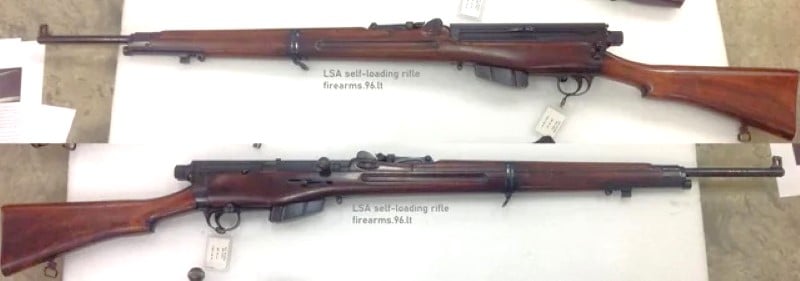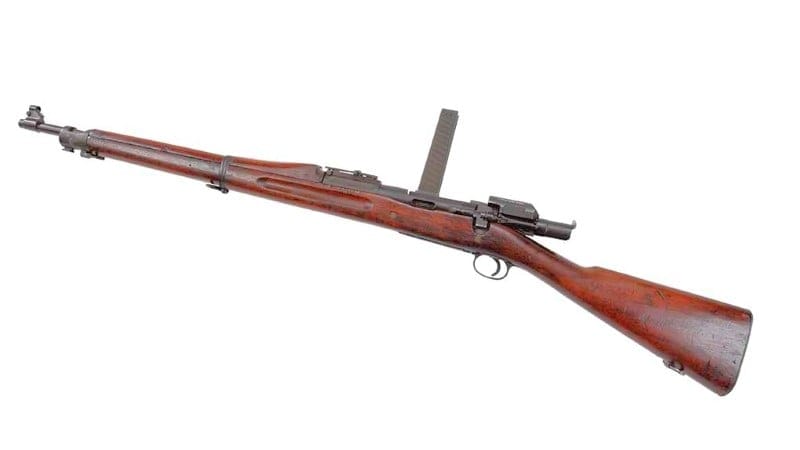World War I was the “War To End All Wars.” Without a doubt, it was an as-yet unparalleled killing ground that demanded the latest techniques in exterminating our fellow man.
Trench warfare made its debut in this war, and both sides were busy coming up with new ideas to attempt to break the stalemate that the trenches presented. Most ended in their experimental phase, but a few went on to see success. We’ll take a look at a few of the guns they came up with, here.
France had the Chauchat. Germany had the MP-18. Austria had the MP-12/MP-16 and the Sturmpistole. The Italians had the Villar Perosa and the Revelli-Beretta. We’ll take a look at a couple here.
British LSA .276 Self-Loading Rifle
Submitted in 1910 to the Small Arms Committee, the British LSA .276 Self-Loading Rifle was the invention of Thomas R. Ashton of London Small Arms. This rifle was recoil-operated and chambered in .276 Enfield. It was magazine-fed by detachable SMLE (Short, Magazine Lee-Enfield) magazines.
Unfortunately, this rifle was highly susceptible to sand and dirt, and was rejected.

It was common for each country to delve into semi-automatic firearms during this time period, as they wanted to provide their troops with more firepower. Interestingly, all the way up through World War II, most countries were still arming their troops with bolt action rifles, at least at the beginning of the war. Of course, the US had its M1 Garand, but at the start of the war, they too were in short supply.
Villar Perosa
Basically, the Villar Perosa was two long-barreled automatic pistols connected together, featuring a spade grip in the rear. It was presented to the British in 1915 by Italian representative, Dr. Bernachi. The proposal was sent to General Headquarters in France, but they did not see an application for such a weapon. It was rechambered to .455 Webley, but the British were still non-plussed, and the project died out.

Ribeyrolles 1918
Officially named the Carabine Mitrailleuse, it was an automatic rifle made by the French. Chambered in the experimental 8x35mm round, it was fed by a 25-round box magazine and it featured a bipod. The rifle experienced reliability issues that hurt its chances for success. It also looked futuristic for the time, and the French military could not see its value. It was destined to fail.
Bergmann MP-18
One weapon that went from experimental to operational in a most direct fashion was the Bergmann MP-18 from Germany. It turned out to be the first mass-produced submachine gun in history.

Designed by Hugo Schmeisser, it was approximately 32 inches long, weighed nine pounds, and was capable of firing 500 rounds per minute. The caliber was 9mm, and it was a devastating, close-range weapon. In 1918, about 10,000 MP-18s were manufactured, and they were used by stormtrooper battalions for trench raids, among other missions. The method of feed included a 32-round drum magazine, as well as other straight magazines of 20 and 30-round capacities.
Pedersen Device
In their quest for increased firepower, the Allies came up with what was known as the Pedersen Device. It was fitted into a bolt-action Springfield .30-06 rifle. It was officially known as the “Automatic Pistol Caliber .30 Model of 1918.” Curiously, that official designation of “Pistol” was intended to mislead our enemies.
John Pedersen, an employee at Remington Arms, had a vision to drastically increase the firepower of the average infantryman. The 1903 MK 1 rifles that were intended for use with the Pedersen Device had a small port milled into the left side of the receiver so the spent casings could be ejected. The device itself replaced the bolt of the Springfield and also featured a barrel for the .30 caliber cartridge. Despite the modifications to the rifles, they could still function as standard bolt-action rifles if the devices were not installed.

The device allowed a 7.62mm (.30 caliber) pistol-type round to be fired semi-automatically, turning the rifle into a blowback-operated weapon. Feeding was accomplished via a long, 40-round stick magazine that stuck out of the rifle diagonally at 45° on the top right side.
Approximately 65,000 Pedersen Devices were manufactured with the intention of using them in the Spring Offensive in 1919. However, the war ended on November 11, 1918. Aside from the actual devices manufactured, there were also 1.6 million magazines, 65 million cartridges, and 101,775 Springfield rifles produced for the project. Suffice it to say, the American Army was substantially invested in this project.
The devices, their magazines, and ammunition were relegated to storage and declared to be surplus in 1931. The Army decided that they didn’t want to pay for storing the devices, so they were eventually destroyed, aside from a small sampling that was retained by the Ordnance Department. Fewer than 100 escaped destruction, and as such, they are now very valuable collector’s items.
Experimental Semi-Automatic Rifle .303 British — Circa 1909
The Farquhar-Hill Rifle, designed by Moubray Farquhar and Arthur Hill, was one of the first semi-auto rifles designed in the 20th century. The caliber was .303 British, and it was fed by a 19-round drum, although a 65-round drum was also available. It featured a recoiling barrel and a recoil spring, which stored the energy to cycle the next round. Unfortunately, it was a complex design and did not far well for military use.

In 1911, Farquhar and Hill implemented revisions to the operating system, going with a gas operation to replace the barrel recoil system. Simplifications to the design not only made it more accurate but also more reliable. The design was tested by the British Army and further refined.
In 1918, the rifle was found to be suitable after various trials at the front, including by observers in aircraft. A request by the British Government went out in an attempt to procure up to 100,000 of the rifles. However, the war ended before production facilities were procured, and in 1919, the order was canceled.
Flamethrower
Well, I’ll confess that the flamethrower was eventually not “experimental,” having met with success and being issued. But hey, at one point, like every weapon, it was technically experimental. It’s also not technically a “gun,” but it became such a substantial implement of not only World War I, but also World War II, the Korean War, and even in Vietnam.
The flamethrower was initially invented by Richard Fiedler, a German engineer, in 1900. Accepted by the German Army in 1911, it was used by assault engineer units.

On February 26th, 1915, the flamethrower was used for the first time in combat by the German 3rd Guard Pioneer Regiment. They used them in an attack against French trenches on the Western Front near Verdun.
It was capable of projecting a jet of flame out to 20 yards and was carried and operated by a single infantryman. One man could only carry a small amount of fuel on his back, so the weapon had to be used sparingly. However, it capitalized on man’s fear of being burned alive. It proved to be an effective weapon that induced terror into those it was being used against.
Aside from its effectiveness at burning its victims, it would also suffocate victims by using up all the oxygen in the area. Troops occupying bunkers and dugouts in trenches could be killed without destroying the fighting positions, allowing the Germans to occupy the fortifications once the troops had been taken out.
Needless to say, flamethrower operators quickly became the Number One target of those facing them on the battlefield. This held true not only in World War I but everywhere on the battlefield through all conflicts.
Conclusion
As you can see, the years leading up to and including World War I were rich with new ideas for the battlefield. Some were quite successful, while others were not up to the task due to poor or overcomplicated design. The demands of trench warfare, with the associated mud, filth, and terrible conditions were quite demanding on weapons. Usually, simpler was better under such circumstances.


